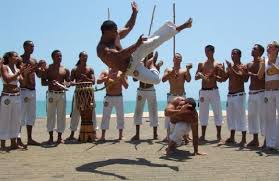Capoeira is a graceful martial art that originated in Brazil. Angolan slaves who were transported to Brazil in the 16th century are the basis of the now very popular self defense technique.
Capoeira is based on traditional African dances and rituals practiced by slaves in their free time. Obviously prohibited slavers and Portuguese colonists the possession of weapons and any kind of martial arts. Therefore Capoeira was carried out as an innocent looking dance. The art was perfected in shelters during the 17th century. The combination of various techniques permits Capoeira one of the most spectacular martial arts.
 After the abolition of slavery in the second half of the nineteenth century Capoeira was banned in Brazil until 1932, because it was associated too much with violence and crime. Since the ‘30s of the 20th century Capoeira again was readmitted, recognized and danced. The original style (capoeira angoloa) is slow and low. The new form of Capoeira (Regional) is faster, with flips, and is played on multiple berimbau 's (one-stringed calabash). Capoeira is, after football, the most performed sport of Brazil. Capoeira in Brazil is also used in projects with street children and the mentally handicapped. Capoeira has grown by a mix of various cultures of various nations.
After the abolition of slavery in the second half of the nineteenth century Capoeira was banned in Brazil until 1932, because it was associated too much with violence and crime. Since the ‘30s of the 20th century Capoeira again was readmitted, recognized and danced. The original style (capoeira angoloa) is slow and low. The new form of Capoeira (Regional) is faster, with flips, and is played on multiple berimbau 's (one-stringed calabash). Capoeira is, after football, the most performed sport of Brazil. Capoeira in Brazil is also used in projects with street children and the mentally handicapped. Capoeira has grown by a mix of various cultures of various nations.
In the entire world it is becoming more famous and more practiced everywhere.
Capoeira looks like a very acrobatic dance, but the movements have always maintained their defensive and offensive nature of the combat sports. Capoeira is practiced by two players in a circle (the roda) of capoeiristas. That encourage the players with music, clapping and traditional songs. This encourages players to make spectacular moves and to defeat their opponent. It is important that you never turn your back to the opponent. Contests are like a street fight because there are no rules for Capoeira. The loser is the one that has most stains on his white clothing by contacts with the feet of the opponent and the ground.
In Capoeira you have different grades such as karate or judo too. You start off with a white belt, then follows yellow and orange. The top strap is black, thus you ‘re a master in Capoeira. People with a white band often see Capoeira more as lifestyle than just as a dance or sports.
The music that accompanies the Capoeira is about life, about the sport or the history of Capoeira. The main tools used for this are the altabac (a conga), the Berim bao and the pandeiro (tambourine). The music is (in principle) life made in the circle.
You can start practicing Capoeira to learn more about different cultures, or for flexibility, your weight or condition, or dancing, or just because you like it. After about six months you normally master the basic movements of Capoeira.
